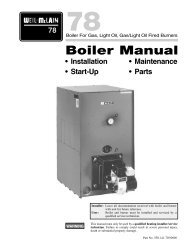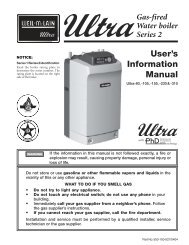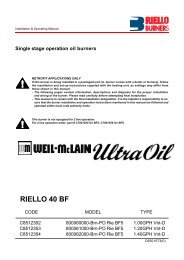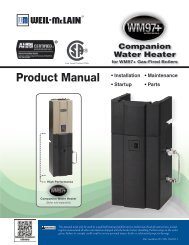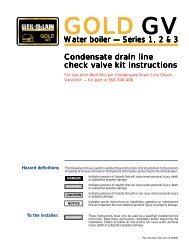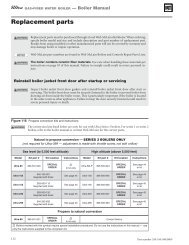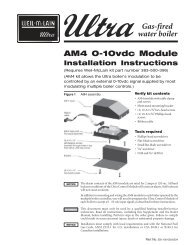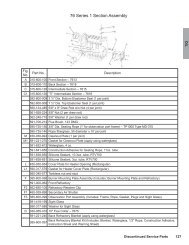Weil McLain Troubleshooting Guide
Weil McLain Troubleshooting Guide
Weil McLain Troubleshooting Guide
Create successful ePaper yourself
Turn your PDF publications into a flip-book with our unique Google optimized e-Paper software.
Copyright© 2006<br />
C-1013
Plus Water Heaters Service Technician’s <strong>Troubleshooting</strong> <strong>Guide</strong><br />
This guide is to be used in conjunction with all GOLD and ULTRA Plus<br />
30/40/60/80 and PLUS 100/110/119/120 Indirect Fired Water Heater<br />
Technical Specification Manuals Maintenance <strong>Guide</strong>.<br />
Good Trouble Shooting Practices<br />
Before leaving for the job site:<br />
• Check your parts and tools.<br />
- Test equipment and tools that you will need:<br />
Electrical meter that can measure voltage and continuity<br />
Pressure gauge, Watts #276H300 test gauge<br />
Temperature gauge and Stopwatch<br />
Bucket, 1 gallon or larger with volume markings<br />
Thermostat (Aquastat) W-M P/N 633-900-130 for GOLD/Ultra Plus<br />
30/40/60/80<br />
Thermostat (Aquastat) W-M P/N 635-100-010 for PLUS 100/110/119/120<br />
Drywell seal repair kit W-M P/N 635-600-150<br />
• Know the water heater model number.<br />
• Know boiler manufacturer and model number.<br />
• Have the Installation and Maintenance Manual and/or wiring and piping<br />
schematic readily available.<br />
Get the latest revisions from www.<strong>Weil</strong>-<strong>McLain</strong>.com<br />
Remember !!<br />
Follow the <strong>Troubleshooting</strong> <strong>Guide</strong> step by step, always double checking your<br />
results. Skipping steps or not completing steps can lead to wrong conclusions,<br />
repeated visits to the job site, and unhappy customers.<br />
Copyright© 2006<br />
1
INSUFFICIENT<br />
HOT WATER<br />
EXCESSIVE DOMESTIC<br />
WATER TEMPERATURE<br />
BOILER RELIEF<br />
VALVE LIFTING<br />
OR WEEPING<br />
TEMPERATURE/<br />
PRESSURE RELIEF<br />
VALVE LIFTING<br />
OR WEEPING<br />
WATER FOUND ON<br />
THE FLOOR NEAR<br />
THE TANK<br />
TOP OF TANK/<br />
INSULATION WET<br />
WATER QUALITY<br />
PROBLEMS<br />
Yes<br />
Yes<br />
Yes<br />
Yes<br />
Yes<br />
Yes<br />
Yes<br />
Insufficient Hot Water - page 3<br />
- Undersized water heater<br />
- Boiler system improperly sized<br />
- Check component parts<br />
- Boiler operating temperature<br />
- Location of flow control devices<br />
- Air in system<br />
- Clean boiler system<br />
Excessive Water Temperature - page 6<br />
- Reduce Stacking<br />
- Lowering boiler operating temperature<br />
- Relocating T-stat bulb<br />
- Reverse boiler piping<br />
- Install thermostatic mixing valve<br />
- Recirculation loop<br />
Boiler Relief Valve Lifting or Weeping - page 7<br />
- Undersized boiler expansion tank<br />
- Faulty boiler expansion tank<br />
- Simulate maximum expansion<br />
- Faulty boiler relief valve<br />
- Faulty boiler fill valve<br />
- Inner tank leak<br />
T&P Relief Valve Lifting or Weeping - page 8<br />
- Undersized or missing domestic side expansion tank<br />
- Faulty domestic expansion tank<br />
- Faulty T&P relief valve<br />
- High domestic supply pressure<br />
- Possible water hammering or pressure spikes<br />
- Boiler operating temperature<br />
Water on the Floor - page 9<br />
- From sources other than the water heater<br />
- T&P valve lifting and discharging<br />
- Loose piping connections<br />
Top of Tank / Insulation Wet - page 10<br />
- From sources other than the water heater<br />
- Loose piping connections<br />
- Leakage from the drywell<br />
Water Smells / Taste Bad - page 11<br />
- Water smells like "rotten eggs"<br />
- Milky water<br />
- Rusty discolored water<br />
2
Is the water heater undersized for the application? (Non-Warranty)<br />
- There are many methods of sizing various applications, i.e. ASHRAE sizing tables, or<br />
ASPE domestic water heating design manual, re-confirm the water demand required for<br />
the application.<br />
- Re-confirm the flow rates of the fixtures. Was the tank sized for shower heads at 2.0 gpm,<br />
when the actual heads are 5.0 gpm? Use a bucket and a stopwatch to determine fixture<br />
flow rates.<br />
- Evaluate the hot water usage pattern for a day. Is the peak demand unusually high for the<br />
application?<br />
- Has the demand for domestic hot water changed since the system was installed? A<br />
bathroom remodeling project with a newly installed whirlpool tub will drastically change<br />
the domestic water demand.<br />
Is the boiler system properly sized? (Non-Warranty)<br />
- Is the boiler providing the required output of BTU’s to meet the domestic water load?<br />
Domestic Demand gph=<br />
Blr Output BTU’s<br />
(Temp. Rise F x 8.33)<br />
Temp Rise ºF = Desired Temp.ºF - Incoming Temp.ºF<br />
8.33 = Density of Water lbs/gal. x 1 Btu/lbs ºF<br />
Example: A single family home with a 3.0 gpm shower fixture and a 150,000 Btu/hr output<br />
boiler capacity. Is the boiler capacity adequate to deliver 115ºF water for an extended period?<br />
Domestic Demand gph=<br />
150,000 Btu/hr<br />
[(115 F-50 F) x 8.33]<br />
= 277 gph<br />
The boiler capacity is capable of delivering 4.6 gpm continuously which is<br />
adequate for this application.<br />
Action Item:<br />
- Measure the BTU input to the boiler by clocking the gas meter or finding the oil flow rate<br />
based on nozzle size and pump pressure.<br />
- Does the hot water system need to be wired for domestic priority? For systems in which<br />
either the storage or BTU’s available are marginal, it is recommended to wire the domestic<br />
water heater in a priority manner.<br />
- Is the boiler piping to the water heater properly sized to allow the required flow rate for<br />
maximum BTU transfer? The temperature differential of the boiler supply and return<br />
water should be 20ºF to 30ºF.<br />
3
- Is the circulator between the boiler and the water heater properly sized to provide adequate<br />
flow for maximum BTU transfer?<br />
PIPE SIZE FLOW RATE BTU'S TRANSFER<br />
3/4" 3 to 7 gpm 50 to 100 MBH<br />
1" 4 to 11 gpm 100 to 180 MBH<br />
1 1/4" 6 to 16 gpm 160 to 300 MBH<br />
1 1/2" 9 to 23 gpm 200 to 450 MBH<br />
2" 15 to 40 gpm 300 to 650 MBH<br />
Check component parts<br />
- Is the domestic water thermostat functioning properly? With a electrical voltmeter check<br />
for continuity between terminals C and 1 on the snap-set connection.<br />
Action Item:<br />
1. Disconnect the snap-set connector on the water heater.<br />
2. Turn the thermostat knob to the highest setting - clockwise to initiate a call for heat.<br />
3. Check for continuity between terminals C and 1 (end connectors on the snap-set). On a<br />
call for heat, these contacts should be in the close position.<br />
4. Continue checking for continuity while turning the thermostat knob to the lowest setting<br />
- counter clockwise to satisfy the call for heat. The contacts should open, breaking the<br />
continuity.<br />
5. If any of these steps fail (1-4 above), replace the thermostat. (Warranty)<br />
For 30/40/60/80 - P/N 633-900-130 for 100/110/119/120 - P/N 635-100-010.<br />
6. Reconnect the snap-set.<br />
- Is the thermostat setting too low? If the thermostat setting is too low, the boiler may not<br />
have the opportunity to deliver the maximum BTU’s required to completely heat the<br />
entire volume of water stored in the tank.<br />
- During a call for heat by the water heater, does the boiler circulator begin pumping, does<br />
the zone valve open, does the boiler fire? Check every component in the system to ensure<br />
they are properly functioning.<br />
- Check the thermostat sensing bulb size and fit into the drywell. Some older units have a<br />
sensing bulb that is thinner and fits loose inside the drywell. The newer thermostats have a<br />
larger bulb which fits tighter in the drywell allowing better heat transfer for more accurate<br />
water temperature sensing.<br />
Action Item:<br />
- If the sensing bulb does not slide into the drywell; remove burrs from top 1 1/2” inside the<br />
drywell with a 3/8” drill.<br />
4
- What is the location of the thermostat bulb? A bulb inserted completely at the bottom of<br />
the drywell will initiate a quicker response for a call for heat. This is typically the position<br />
of the bulb required for applications in which there are large draws of domestic water.<br />
- Remove and examine the dip tube located in the cold water inlet. Replace if damaged. A<br />
broken or melted dip tube will cause the cold water to discharge across the top of the tank,<br />
thus short cycling the water heater.<br />
Check the operating temperature of the boiler (Non-Warranty)<br />
- If possible increase the boiler operating temperature to 200ºF.<br />
- Maintain a minimal temperature in the boiler during non-heating seasons. A boiler<br />
typically has a higher standby loss than the indirect water heater. After a long standby<br />
period, the colder boiler may absorb the stored energy within the water heater during the<br />
initial call for heat.<br />
Check location of flow control devices (Non-Warranty)<br />
- Lab tests have shown that during long standby periods the boiler piping can act as a<br />
thermal siphon and draw stored heat from the domestic water. Locate flow control devices<br />
(zone valve, spring check valves...) or heat trap loops in the boiler piping close to the water<br />
heater. Insulate all boiler piping to and from the water heater.<br />
Check for air in the system (Non-Warranty)<br />
- An air bound water heater or boiler will not circulate system water properly, resulting in a<br />
lack of heat transfer.<br />
Clean the boiler system (Non-Warranty)<br />
- A dirty boiler system can cause deposits to form on the outer wall of the inner tank, which<br />
insulates the tank, affecting the heat transfer. Clean the boiler system per the boiler’s<br />
manufacturer’s instructions.<br />
Action Item:<br />
- Install a strainer in the boiler piping on older installations or for systems prone to<br />
becoming dirty.<br />
5
Excessive water temperature is usually the result of stacking within the water<br />
heater. Stacking is the occurrence of various water temperatures layering within<br />
the water heater with the hottest water in the uppermost layer. This layering or<br />
stacking effect typically occurs during small draws of hot water (typically less<br />
than 25% of the storage capacity) which are long enough to create a call for heat<br />
on the thermostat, but are short enough not to deplete the stored energy within<br />
the tank. Excessive stacking can occur when frequent short to moderate draws<br />
are taken in quick succession. During this type of situation, the temperature of<br />
the domestic water can approach the temperature of the boiler water.<br />
REMEMBER: All water heaters (direct and indirect) will stack.<br />
Reducing stacking within the tank (Non-Warranty)<br />
- Reduce the boiler operating temperature to 160ºF - 170ºF. This will limit the maximum<br />
domestic outlet water temperature during high stacking water usage.<br />
- Raise the thermostat sensing bulb higher in the drywell. This will reduce the frequency of<br />
thermostat calls for heat during small draws of hot water. However, it will reduce the<br />
quantity of available hot water during a deep draw by delaying the call for heat to the<br />
boiler.<br />
- Reverse the boiler side piping. The older installations have the boiler supply at the top of<br />
the water heater and return at the bottom. Reversing the piping, supply at the bottom and<br />
return at the top will:<br />
a) Result in lower tank stacking by having the hottest boiler water closer to the cooler<br />
incoming domestic water.<br />
b) Reduce the effect of “thermal overshoot” after the thermostat call for heat has been<br />
satisfied.<br />
c) Provide a more uniform hot water delivery temperature during moderate to deep<br />
draws (25% to 100% of the tank’s storage capacity). Reversing the boiler piping will<br />
not affect the performance of the water heater.<br />
Install thermostatic mixing valve<br />
- Installation of a thermostatic mixing valve will provide an uniform delivery temperature<br />
with minimal regard to water usage.<br />
Recirculation Loop<br />
- Installation of a properly sized recirculation loop not only provides prompt delivery of hot<br />
water, but it provides circulation and mixing of the water within the tank.<br />
6
Is the expansion tank on the boiler side properly sized?<br />
- The additional quantity of boiler water contained in the outer tank must be considered<br />
when sizing the boiler side expansion tank.<br />
<strong>Weil</strong>-<strong>McLain</strong> Water Heater Model Boiler Side Capacity Gal.<br />
GOLD Plus 30 5<br />
GOLD/Ultra Plus 40 6<br />
GOLD/Ultra Plus 60 8<br />
GOLD/Ultra Plus 80 8<br />
Comm. PLUS 100 Series 2/Series 3 8/14<br />
Comm. PLUS 110 25<br />
Comm. PLUS 119/120 43<br />
- Insufficient allowance for expansion on the boiler side can cause the boiler pressure relief<br />
valve to lift.<br />
Is the expansion tank defective, waterlogged or improperly charged?<br />
(Non-Warranty)<br />
- Check for failed gaskets or bladders, or a faulty Schraeder valve.<br />
- Use a tire gauge to check the charged pressure of the tank.<br />
Action Item:<br />
- Turn the boiler limit up to a higher setting and let the system run at a higher temperature.<br />
This will simulate maximum expansion in the boiler system.<br />
- If the boiler relief valve lifts and/or there is a significant increase in the boiler system<br />
pressure, the expansion tank is flooded or undersized.<br />
Is the boiler pressure relief valve functioning properly? (Non-Warranty)<br />
- Dirt and water deposits can accumulate under the valve seat.<br />
Check the boiler automatic fill valve for defects. (Non-Warranty)<br />
- Is the valve filling to the correct pressure?<br />
Check for possible ‘inner tank leak’ *reason code 054<br />
- If possible, isolate the Plus tank from the boiler system for an extended period of time.<br />
Observe the boiler system pressure during that time.<br />
* This may be a manufacturing defect. Please initiate a warranty claim with <strong>Weil</strong>-<strong>McLain</strong><br />
noting the reason code listed.<br />
7
Is there a thermal expansion tank installed on the domestic supply piping<br />
and is it properly sized? (Non-Warranty)<br />
- A thermal expansion tank is required if the domestic supply piping includes a backflow<br />
preventer or pressure reducing valve.<br />
- Ensure the potable water expansion tank is properly sized according to the water heater<br />
volume and supply pressure.<br />
- During long periods when there are no draws from the tank (i.e. overnight), the T&P<br />
relief valve may lift or weep due to thermal expansion, but may function properly during<br />
normal periods of tank draws.<br />
Is the expansion tank defective, water logged or improperly charged?<br />
(Non-Warranty)<br />
- Check for failed gaskets or bladders, or a faulty Schraeder valve.<br />
- Use a tire gauge to check the charged pressure of the tank.<br />
Is the temperature/pressure relief valve functioning properly?<br />
- Dirt and water deposits can accumulate under the valve seat.<br />
Check the domestic supply pressure entering the water heater.<br />
(Non-Warranty)<br />
- If the pressure is over 70 psi, it is recommended to install a pressure reducing valve. This<br />
will prevent any pressure spikes or increases in pressure due to thermal expansion which<br />
may cause the T&P valve to lift or weep.<br />
Check the domestic system for possible sources of water hammering or<br />
pressure spikes.<br />
- Some appliances, such as clothes washers and dishwashers, utilize fast acting valves which<br />
may cause water hammering or pressure spikes through the domestic water system.<br />
Action Item:<br />
- Install water hammer arrestors as required per the manufacturer’s instructions, or install<br />
flexible connectors to isolate the tank from the domestic system.<br />
Check the operating temperature of the boiler.<br />
- If the boiler operating temperature is excessive, greater than 200ºF, stacking can occur in<br />
the inner tank raising the domestic water temperature close to the boiler operating<br />
temperature.<br />
Action Item:<br />
- Reduce the boiler operating temperature to 180ºF.<br />
8
Is the source of water from the tank?<br />
- Check for possible water seepage through foundation cracks. Did the water appear after a<br />
heavy rain? (Non-Warranty)<br />
Is the source of water from the T&P relief valve?<br />
- Place a bucket under the discharge piping of the T&P relief valve and monitor it for a day<br />
or two. This is a procedure that can be done by the homeowner.<br />
- If the T&P relief valve is the source, refer to the T&P Relief Valve section of this guide.<br />
Check all connections – boiler connections, domestic connections…<br />
- Check all the boiler connections to the water heater. A build-up of corrosion is a sure sign<br />
of a leak. (Non-Warranty)<br />
- Check the boiler supply connections. Look at the welds where the spuds enter into the<br />
outer tank. These can be cracked by using excessive force when connecting piping. (Non-<br />
Warranty) If they are leaking and it is NOT related to an installation error or system<br />
problem—*reason code 057.<br />
- Check the domestic connections. Look at the welds where the spuds enter into the outer<br />
tank. Excessive water hammering in the domestic system may crack these welds. (Non-<br />
Warranty) If they are leaking and it is NOT related to an installation error or system<br />
problem.—*reason code 058.<br />
- Check the seal around the air vent for leaks.<br />
- Check the drywell for leaks.<br />
Action Item:<br />
- To replace the drywell use the Replacement Kit. (See chart on Page 15, 17, 19 or 21)<br />
- Apply sealant (i.e. Leaklok or Loctite) completely around threads in all applications.<br />
* This may be a manufacturing defect. Please initiate a warranty claim with <strong>Weil</strong>-<strong>McLain</strong><br />
noting the reason code listed.<br />
9
Is the source of water from the tank?<br />
- Check for possible overhead pipes leaking onto the tank. (Non-Warranty)<br />
Check all connections – boiler connections, air vent…<br />
- Check the connections to the water heater. Are they loose? A build-up of corrosion around<br />
joints is a sure sign of a leak. (Non-Warranty)<br />
- Check the seal around the air vent and drywell for leaks. Remove the drywell and check<br />
the O-ring gasket (if applicable) beneath it. (Non-Warranty) If they are leaking and it is<br />
not related to an installation error or system problem—*reason code 058.<br />
- Remove the thermostat sensing bulb from the drywell. If the bulb wet or is water visible at<br />
the top of the drywell?—*reason code 059.<br />
Action Item:<br />
- To replace the drywell use the Replacement Kit. (See chart on Page 15, 17, 19 or 21)<br />
- Apply sealant (i.e. Leaklok or Loctite) completely around threads in all applications.<br />
* This may be a manufacturing defect. Please initiate a warranty claim with <strong>Weil</strong>-<strong>McLain</strong><br />
noting the reason code listed.<br />
10
The hot water smells like “rotten eggs” (Non-Warranty)<br />
The most common cause of water to smell like “rotten eggs” is a non-toxic<br />
sulfate reducing bacteria. The bacteria usually enters into the water system<br />
through a break in the supply piping or during construction/maintenance of the<br />
supply piping. The bacteria survives in the water system by converting sulfate<br />
(SO4) in the water to hydrogen sulfide (H2S) gas. It is this gas that creates the<br />
“rotten egg” smell. The presence of hydrogen sulfide can also affect the taste of<br />
the water as well. Along with the stench caused by this bacteria, black deposits<br />
(which typically indicate pipe and/or fitting corrosion) may also appear in the<br />
water.<br />
WARNING!<br />
In extremely high concentrations, hydrogen sulfide gas can be toxic.<br />
However, the gas is detectable prior to reaching harmful levels.<br />
The bacteria will thrive in any water system under the following conditions:<br />
• High levels of sulfur in the water<br />
• Activated hydrogen in the water from cathodic reactions within the tank<br />
• Water with little or no dissolved oxygen<br />
• Storing the domestic water below 140ºF<br />
Other causes of smelly water:<br />
• Chlorides of magnesium and calcium gives water a bitter taste<br />
• Chloride of sodium will produce a salty tasting water<br />
• Sulfates above 50 ppm in the water gives the water a medicinal taste<br />
• Carbon dioxide in water with a low pH results in water that is fizzy<br />
• Iron and tannic waters will produce water with a bad taste and odor<br />
Action Item:<br />
- The treatment of this situation requires the water system to be shockchlorinated.<br />
Depending on the severity of the bacteria within the water system, several treatments may<br />
be needed.<br />
11
Hot water from the faucet appears milky (Non-Warranty)<br />
When water is initially drawn from the faucet it appears to be milky or<br />
cloudy, but it becomes clear after the water is allow to stand for several minutes.<br />
This is usually an indication that the water contains high levels of soluble gases<br />
such as oxygen, chlorine, carbon dioxide, hydrogen sulfide or others. As the<br />
water system pressure increases, the amount of gas that water can hold in a<br />
solution decreases. When air and gases are forced out of the heated water, the<br />
problem may be evident in one or both of the following conditions:<br />
• Gases, in the form of small bubbles, may make the water appear milky from the tap, but<br />
clear after several minutes when those bubbles will separate. Similar to the reaction that<br />
occurs as air bubbles form on the walls of a pan shortly before the water begins to boil.<br />
• The release of dissolved gas can also create air pockets and air locks in the water system<br />
piping. This can cause spurts of air or gases when opening the hot water faucet.<br />
There is generally no cure for milky water caused by dissolve gases, although<br />
it can be reduced with aerated faucets. In some applications, the amount of air<br />
and gases precipitating out of the water will reduced in time. It should be noted<br />
that these gases are not harmful to the end user.<br />
12
Discolored water from the hot water faucet (Non-Warranty)<br />
The water from the hot water faucet appears discolored, either rusty, brown,<br />
black or yellow. Because the inner tank is stainless steel, which by its nature is<br />
resistant to corrosion, the problem is not tank related. The problem is usually a<br />
non-toxic iron reducing bacteria that is commonly found in soil, well water,<br />
water treatment plants and piping systems. The bacteria usually thrives in those<br />
systems in which the soluble iron exceeds 0.2 ppm. The bacteria will feed on the<br />
soluble iron in the water producing “rusty” color water as a by-product of the<br />
feeding process.<br />
Variables in which the bacteria can thrive in:<br />
• Elevated levels of iron and manganese in the water<br />
• Water with little or no dissolved oxygen<br />
• Water storage temperatures below 140ºF<br />
Items that can potentially increase the presence of the bacteria:<br />
• Water softeners<br />
• Well water<br />
• Long periods of no water movement<br />
Action Item:<br />
- The treatment of this situation requires the water system to be shockchlorinated.<br />
Depending on the severity of the bacteria within the water system, several treatments may<br />
be needed.<br />
Check the ph and the Chlorides of the water in both the inner (domestic) tank<br />
and the outer (boiler) tank. Ph must be between 6 and 8. The chloride must be<br />
less than 80mg/l. Note the ph and Chloride readings on the RGA Paperwork.<br />
Items that can affect the ph reading:<br />
1) Water Softeners<br />
2) Water treatment plants<br />
a) Cl ( Chlorides) added, especially during the summer<br />
b) Fl ( Fluorides) added in treatment in large cities<br />
3) Elevated levels of iron, manganese, and sulfur<br />
If the ph is out of range it has a big effect on the metal tanks, piping and heat<br />
transfer surfaces.<br />
13




